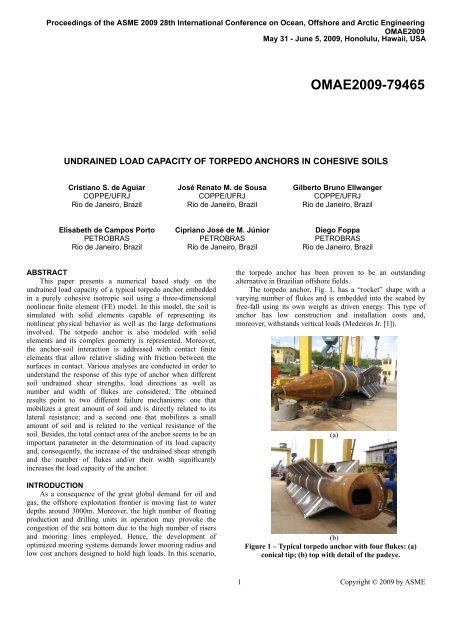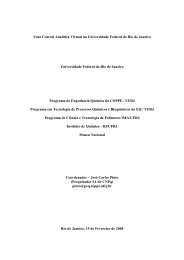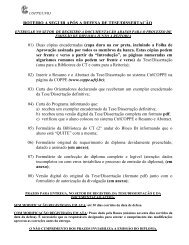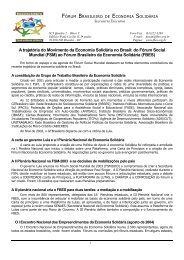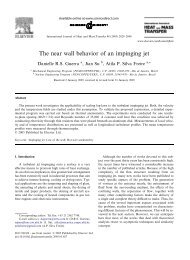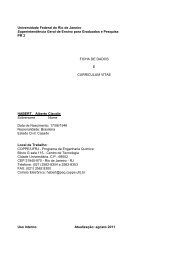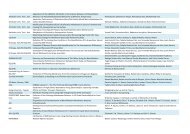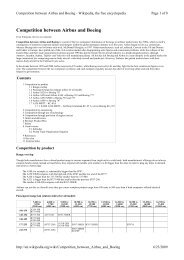Undrained Load Capacity of Torpedo Anchors in ... - laceo - UFRJ
Undrained Load Capacity of Torpedo Anchors in ... - laceo - UFRJ
Undrained Load Capacity of Torpedo Anchors in ... - laceo - UFRJ
Create successful ePaper yourself
Turn your PDF publications into a flip-book with our unique Google optimized e-Paper software.
Proceed<strong>in</strong>gs <strong>of</strong> the ASME 2009 28th International Conference on Ocean, Offshore and Arctic Eng<strong>in</strong>eer<strong>in</strong>g<br />
OMAE2009<br />
May 31 - June 5, 2009, Honolulu, Hawaii, USA<br />
Proceed<strong>in</strong>gs <strong>of</strong> the ASME 28th International Conference on Ocean, Offshore and Arctic Eng<strong>in</strong>eer<strong>in</strong>g<br />
OMAE2009<br />
May 31 – June 5, 2009, Honolulu, Hawaii<br />
OMAE2009-79465<br />
OMAE2009-79465<br />
UNDRAINED LOAD CAPACITY OF TORPEDO ANCHORS IN COHESIVE SOILS<br />
Cristiano S. de Aguiar<br />
COPPE/<strong>UFRJ</strong><br />
Rio de Janeiro, Brazil<br />
José Renato M. de Sousa<br />
COPPE/<strong>UFRJ</strong><br />
Rio de Janeiro, Brazil<br />
Gilberto Bruno Ellwanger<br />
COPPE/<strong>UFRJ</strong><br />
Rio de Janeiro, Brazil<br />
Elisabeth de Campos Porto<br />
PETROBRAS<br />
Rio de Janeiro, Brazil<br />
Cipriano José de M. Júnior<br />
PETROBRAS<br />
Rio de Janeiro, Brazil<br />
Diego Foppa<br />
PETROBRAS<br />
Rio de Janeiro, Brazil<br />
ABSTRACT<br />
This paper presents a numerical based study on the<br />
undra<strong>in</strong>ed load capacity <strong>of</strong> a typical torpedo anchor embedded<br />
<strong>in</strong> a purely cohesive isotropic soil us<strong>in</strong>g a three-dimensional<br />
nonl<strong>in</strong>ear f<strong>in</strong>ite element (FE) model. In this model, the soil is<br />
simulated with solid elements capable <strong>of</strong> represent<strong>in</strong>g its<br />
nonl<strong>in</strong>ear physical behavior as well as the large deformations<br />
<strong>in</strong>volved. The torpedo anchor is also modeled with solid<br />
elements and its complex geometry is represented. Moreover,<br />
the anchor-soil <strong>in</strong>teraction is addressed with contact f<strong>in</strong>ite<br />
elements that allow relative slid<strong>in</strong>g with friction between the<br />
surfaces <strong>in</strong> contact. Various analyses are conducted <strong>in</strong> order to<br />
understand the response <strong>of</strong> this type <strong>of</strong> anchor when different<br />
soil undra<strong>in</strong>ed shear strengths, load directions as well as<br />
number and width <strong>of</strong> flukes are considered. The obta<strong>in</strong>ed<br />
results po<strong>in</strong>t to two different failure mechanisms: one that<br />
mobilizes a great amount <strong>of</strong> soil and is directly related to its<br />
lateral resistance; and a second one that mobilizes a small<br />
amount <strong>of</strong> soil and is related to the vertical resistance <strong>of</strong> the<br />
soil. Besides, the total contact area <strong>of</strong> the anchor seems to be an<br />
important parameter <strong>in</strong> the determ<strong>in</strong>ation <strong>of</strong> its load capacity<br />
and, consequently, the <strong>in</strong>crease <strong>of</strong> the undra<strong>in</strong>ed shear strength<br />
and the number <strong>of</strong> flukes and/or their width significantly<br />
<strong>in</strong>creases the load capacity <strong>of</strong> the anchor.<br />
INTRODUCTION<br />
As a consequence <strong>of</strong> the great global demand for oil and<br />
gas, the <strong>of</strong>fshore exploitation frontier is mov<strong>in</strong>g fast to water<br />
depths around 3000m. Moreover, the high number <strong>of</strong> float<strong>in</strong>g<br />
production and drill<strong>in</strong>g units <strong>in</strong> operation may provoke the<br />
congestion <strong>of</strong> the sea bottom due to the high number <strong>of</strong> risers<br />
and moor<strong>in</strong>g l<strong>in</strong>es employed. Hence, the development <strong>of</strong><br />
optimized moor<strong>in</strong>g systems demands lower moor<strong>in</strong>g radius and<br />
low cost anchors designed to hold high loads. In this scenario,<br />
the torpedo anchor has been proven to be an outstand<strong>in</strong>g<br />
alternative <strong>in</strong> Brazilian <strong>of</strong>fshore fields.<br />
The torpedo anchor, Fig. 1, has a “rocket” shape with a<br />
vary<strong>in</strong>g number <strong>of</strong> flukes and is embedded <strong>in</strong>to the seabed by<br />
free-fall us<strong>in</strong>g its own weight as driven energy. This type <strong>of</strong><br />
anchor has low construction and <strong>in</strong>stallation costs and,<br />
moreover, withstands vertical loads (Medeiros Jr. [1]).<br />
(a)<br />
(b)<br />
Figure 1 – Typical torpedo anchor with four flukes: (a)<br />
conical tip; (b) top with detail <strong>of</strong> the padeye.<br />
1 Copyright © 2009 by ASME
<strong>Torpedo</strong> anchors were first employed to hold flexible risers where [ Δσ] = [ Δσ<br />
] T<br />
xx Δσ<br />
yy Δσ<br />
zz Δτ<br />
xy Δτ<br />
xz Δτ<br />
yz is the<br />
just after their touchdown po<strong>in</strong>ts (TDP) <strong>in</strong> order to avoid that<br />
the loads generated by the float<strong>in</strong>g units movements were<br />
<strong>in</strong>cremental total stress vector;<br />
transferred to subsea equipments such as wet Christmas trees [ Δε<br />
] = [ Δε<br />
] T<br />
xx Δε<br />
yy Δε<br />
zz Δγ<br />
xy Δγ<br />
xz Δγ<br />
yz is the <strong>in</strong>cremental<br />
(Medeiros Jr. [1]). In 2003, a high hold<strong>in</strong>g capacity torpedo total stra<strong>in</strong> vector; and [ D<br />
ep<br />
] is the constitutive elasto-plastic<br />
anchor was designed to susta<strong>in</strong> the loads imposed by the<br />
matrix (Potts and Zdravkovic [4]):<br />
moor<strong>in</strong>g l<strong>in</strong>es <strong>of</strong> Petrobras FPSO P-50 (Araújo et al. [2]). S<strong>in</strong>ce<br />
E<br />
[ Δσ] [ Dep ] [ Δε]<br />
K s =<br />
3⋅<br />
1−<br />
2⋅υ<br />
(6)<br />
then, other float<strong>in</strong>g production systems have been anchored<br />
T<br />
us<strong>in</strong>g the torpedo concept (Brandão et al. [3]).<br />
⎧∂P<br />
[ ]<br />
([ σ] ,[ m]<br />
) ⎫ ⎧∂F( [ σ][ , k]<br />
) ⎫<br />
D ⋅ ⎨ ⎬ ⋅ ⎨ ⎬ ⋅ [ D]<br />
Despite its large use <strong>in</strong> Brazilian <strong>of</strong>fshore applications, the<br />
[<br />
calculus <strong>of</strong> the torpedo anchor load capacity and the prediction<br />
] [ ]<br />
⎩ ∂σ<br />
⎭ ⎩ ∂σ<br />
= D −<br />
⎭<br />
T<br />
⎧∂F( [ σ][ , k]<br />
) ⎫ ⎧∂P<br />
<strong>of</strong> the stresses <strong>in</strong> its structure due to the loads imposed by the<br />
[ ]<br />
([ σ][ m]<br />
) ⎫<br />
⎨ ⎬ ⋅ D ⋅ ⎨<br />
⎬<br />
⎩ ∂σ<br />
⎭ ⎩ ∂σ<br />
⎭<br />
attached moor<strong>in</strong>g l<strong>in</strong>e rema<strong>in</strong>s as a great challenge. Thus,<br />
(2)<br />
aim<strong>in</strong>g at accomplish<strong>in</strong>g these tasks, a nonl<strong>in</strong>ear threedimensional<br />
f<strong>in</strong>ite element (FE) model is here proposed. This<br />
where [ D ] is the elastic total stress constitutive matrix;<br />
model employs isoparametric solid elements to represent both P ([ σ ],<br />
[ m]<br />
) is the plastic potential function; F ([ σ ],<br />
[ k]<br />
) is the<br />
the soil and the anchor. These elements are capable <strong>of</strong> yield function; [ σ ] is the stress state <strong>in</strong> the element; [ m ] and<br />
represent<strong>in</strong>g the physical nonl<strong>in</strong>ear behavior <strong>of</strong> the soil and, [ k ] are state parameters related to the plastic potential and yield<br />
eventually, <strong>of</strong> the anchor. Large deformations may also be<br />
functions, respectively.<br />
accounted for. Soil-anchor <strong>in</strong>teraction is assured by surface to<br />
The elastic total stress constitutive matrix can be split <strong>in</strong><br />
surface contact elements placed on the external surface <strong>of</strong> the<br />
two parts, as follows:<br />
anchor and the surround<strong>in</strong>g soil. A general overview <strong>of</strong> this<br />
model is presented <strong>in</strong> Fig. 2.<br />
[ D ] = [ D eff ] + [ D pore ]<br />
(3)<br />
where [ D<br />
eff<br />
] is the effective stress constitutive matrix and<br />
[ D<br />
pore<br />
] is the pore fluid stiffness, which, consider<strong>in</strong>g an<br />
isotropic material loaded under undra<strong>in</strong>ed conditions, are given<br />
by (Zdravkovic and Potts [4]):<br />
⎡ 4 2 2<br />
⎤<br />
⎢K<br />
s + ⋅G<br />
K s − ⋅G<br />
K s − ⋅G<br />
0 0 0<br />
3 3 3<br />
⎥<br />
⎢<br />
4 2<br />
⎥<br />
⎢<br />
K<br />
⎥<br />
s + ⋅G<br />
K s − ⋅G<br />
0 0 0<br />
⎢<br />
3 3<br />
⎥<br />
[ D ] = ⎢<br />
4<br />
⎥<br />
eff<br />
⎢<br />
K s + ⋅G<br />
0 0 0<br />
3<br />
⎥<br />
⎢<br />
symmetric<br />
G 0 0 ⎥<br />
⎢<br />
⎥<br />
⎢<br />
G 0 ⎥<br />
Figure 2 – General view <strong>of</strong> the FE model.<br />
⎢<br />
⎥<br />
⎣<br />
G⎦<br />
(4)<br />
In this paper, a parametric study is conducted consider<strong>in</strong>g a<br />
typical torpedo anchor embedded <strong>in</strong> a purely cohesive isotropic<br />
⎡1<br />
1 1 0 0 0⎤<br />
soil. The effects on the hold<strong>in</strong>g capacity <strong>of</strong> the undra<strong>in</strong>ed soil<br />
⎢<br />
⎥<br />
strength, the number <strong>of</strong> flukes <strong>in</strong> the anchor and the width <strong>of</strong><br />
⎢<br />
1 1 1 0 0 0<br />
⎥<br />
⎢1<br />
1 1 0 0 0⎥<br />
these flukes are evaluated.<br />
[ D pore ] = K pore ⋅ ⎢<br />
⎥<br />
(5)<br />
⎢0<br />
0 0 0 0 0⎥<br />
⎢<br />
⎥<br />
FE MODEL<br />
0 0 0 0 0 0<br />
⎢<br />
⎥<br />
⎢⎣<br />
0 0 0 0 0 0⎥⎦<br />
Soil model<strong>in</strong>g<br />
where K<br />
s<br />
is the bulk modulus <strong>of</strong> the soil, G is the effective<br />
Constitutive matrix<br />
The soil is assumed to be a perfectly elasto-plastic isotropic transverse modulus <strong>of</strong> the soil and K<br />
pore<br />
is the bulk modulus <strong>of</strong><br />
material with physical properties variable with depth. Hence, the fluid, which are given by:<br />
the relation between stresses and stra<strong>in</strong>s is given <strong>in</strong> the form:<br />
( )<br />
2 Copyright © 2009 by ASME
E<br />
G =<br />
(7)<br />
2⋅<br />
K<br />
( 1+υ)<br />
= 1000 ⋅<br />
(8)<br />
pore K s<br />
<strong>in</strong> which E and υ are the soil effective elastic modulus and<br />
Poisson coefficient, respectively.<br />
In order to represent the nonl<strong>in</strong>ear material behavior <strong>of</strong> the<br />
soil, the Drucker-Prager model was chosen. This model<br />
approximates the irregular hexagon <strong>of</strong> the Mohr-Coulomb<br />
failure surface by a circle and, consequently, the Drucker-<br />
Prager yield function is a cyl<strong>in</strong>drical cone as po<strong>in</strong>ted out <strong>in</strong> Fig.<br />
3.<br />
Figure 3 – Drucker-Prager yield surface <strong>in</strong> pr<strong>in</strong>cipal stress<br />
space (Potts and Zdravkovic [4]).<br />
The yield function and plastic potential function for this<br />
model are given by (Chen and Baladi [5]):<br />
([ ][ ]) () 1 (2)<br />
k = J + k ⋅ I k<br />
F σ +<br />
(9)<br />
, 2 DP 1 DP<br />
([ ][ ]) () 1<br />
(2)<br />
m = J + m ⋅ I m<br />
P σ +<br />
(10)<br />
, 2 DP 1 DP<br />
where I 1 and J 2 are, respectively, the first and the second<br />
<strong>in</strong>variant <strong>of</strong> the stress tensor; k () 1 DP , ( 2<br />
k<br />
)<br />
DP , () 1<br />
m DP and ( 2<br />
m<br />
)<br />
DP are<br />
stress state parameters. These parameters depend on the<br />
adopted approximation to the Mohr-Coulomb hexagon and are<br />
functions <strong>of</strong> the <strong>in</strong>ternal friction angle, φ, the dilation angle, ψ,<br />
and the cohesion, c, <strong>of</strong> the soil. Figure 4 presents three possible<br />
approximations and Table 1 presents the values <strong>of</strong> the<br />
parameters for each case:<br />
1. The circle circumscribes the hexagon def<strong>in</strong>ed by the<br />
Mohr-Coulomb criterion and passes through the po<strong>in</strong>ts<br />
<strong>of</strong> maximum tension (extension circle).<br />
2. The circle circumscribes the hexagon def<strong>in</strong>ed by the<br />
Mohr-Coulomb criteria and passes through the po<strong>in</strong>ts<br />
<strong>of</strong> maximum compression (compression circle).<br />
3. The circle <strong>in</strong>scribes the hexagon def<strong>in</strong>ed by the Mohr-<br />
Coulomb criteria.<br />
Figure 4 – Drucker-Prager and Mohr-Coulomb yield<br />
surfaces <strong>in</strong> the deviatoric plane (Potts and Zdravkovic [4]).<br />
1<br />
2<br />
3<br />
Table 1 – Drucker-Prager parameters for different<br />
approximations.<br />
k<br />
( 1 )<br />
() 1<br />
m<br />
( 2) ( 2<br />
k =<br />
)<br />
3 ⋅<br />
DP<br />
DP<br />
DP m DP<br />
⋅ sen( φ)<br />
[ 3 + sen( φ)<br />
]<br />
2 ⋅ sen( ψ )<br />
3 ⋅[ 3 + sen( ψ )]<br />
6 ⋅ c ⋅ cos( φ)<br />
3 ⋅[ 3 + sen( φ)<br />
]<br />
⋅ sen( φ)<br />
2 ⋅ sen( ψ ) 6 ⋅ c ⋅ cos( φ)<br />
[ 3 − sen( φ)<br />
] 3 ⋅[ 3 − sen( ψ )]<br />
3 ⋅[ 3 − sen( φ)<br />
]<br />
sen( φ)<br />
sen( ψ )<br />
3⋅ c cos( φ)<br />
2<br />
3 + sen ( φ)<br />
3 ⋅<br />
2<br />
3 + sen ( ψ ) 3 ⋅<br />
2<br />
3 + sen ( φ)<br />
2<br />
2<br />
3 ⋅<br />
3 ⋅<br />
NOTES:<br />
1: Extension cone (circumscribed).<br />
2: Compression cone (circumscribed).<br />
3: Inscribed cone.<br />
As the model is devoted to the analysis <strong>of</strong> torpedo anchors<br />
<strong>in</strong> undra<strong>in</strong>ed conditions, the undra<strong>in</strong>ed shear strength <strong>of</strong> the<br />
soil, S u , may replace the cohesion, c, <strong>in</strong> the expressions<br />
presented <strong>in</strong> Table 1.<br />
F<strong>in</strong>ally, s<strong>in</strong>ce the elastic constitutive matrix, Eqs. (3) to (8),<br />
the yield and plastic potential functions, Eqs. (9) and (10), are<br />
determ<strong>in</strong>ed, the elasto-plastic constitutive matrix is established.<br />
A particular case <strong>of</strong> the proposed model occurs when the<br />
soil is assumed to be purely cohesive, i. e., φ = 0°. In this case,<br />
the Drucker-Prager yield function, Eq. (9) reduces to:<br />
(2)<br />
([ ] [ k]<br />
) = J k<br />
σ (11)<br />
F , 2 + DP<br />
where, for the circumscribed cyl<strong>in</strong>drical cone approximation,<br />
(2) 2<br />
( 2)<br />
kDP = ⋅ S u and for the <strong>in</strong>scribed cyl<strong>in</strong>drical cone kDP<br />
= ⋅Su<br />
.<br />
3<br />
The Huber-Von Mises yield function is given by (Chen and<br />
Baladi [5]):<br />
([ ], [ k]<br />
) = J2<br />
kVM<br />
F σ +<br />
(12)<br />
3 Copyright © 2009 by ASME
where:<br />
σ y<br />
k VM = (13)<br />
3<br />
torpedo anchor, H p , the length <strong>of</strong> the anchor, H e , and the<br />
distance <strong>of</strong> the tip <strong>of</strong> the torpedo anchor to the bottom <strong>of</strong> the FE<br />
mesh, H a .<br />
and σ y is the yield or failure stress <strong>of</strong> the material.<br />
(2)<br />
In Eqs. (11) and (12), if k VM<br />
are made equal to k<br />
DP , the<br />
Drucker-Prager yield function is equivalent to the Huber-Von<br />
Mises yield function. This leads to equivalent failure stresses,<br />
σ<br />
y<br />
, equal to:<br />
• For the circumscribed cyl<strong>in</strong>drical cone approximation:<br />
σ y = 2 ⋅ S u<br />
(14)<br />
• For the <strong>in</strong>scribed cyl<strong>in</strong>drical cone approximation:<br />
σ y = 3 ⋅ S u<br />
(15)<br />
Another relevant aspect is that the coefficient <strong>of</strong> lateral<br />
earth pressure, K 0 , which is the ratio between the vertical and<br />
horizontal effective stress, is related to the <strong>in</strong>ternal friction<br />
angle by the relation:<br />
( )<br />
K 0 = 1−<br />
s<strong>in</strong> φ<br />
(16)<br />
If the soil is assumed to be purely cohesive, the coefficient<br />
<strong>of</strong> lateral earth pressure is equal to 1,0. However, the Poisson<br />
coefficient can be expressed as:<br />
K0<br />
υ =<br />
(17)<br />
1+<br />
K<br />
0<br />
If K 0 is equal to 1,0, Eq. (16) po<strong>in</strong>ts to a Poisson coefficient<br />
<strong>of</strong> 0,5, which leads to numerical problems <strong>in</strong> the effective stress<br />
constitutive matrix, Eq. (4), s<strong>in</strong>ce all terms become <strong>in</strong>f<strong>in</strong>ite. In<br />
this case, Potts and Zdravkovic [4] suggest that the Poisson<br />
coefficient should be less than 0,490 and not equal to 0,500. In<br />
this work, a value <strong>of</strong> 0,495 is chosen whenever this situation<br />
occurs.<br />
Furthermore, as the Poisson coefficient is close to 0,500,<br />
the material is said to be nearly <strong>in</strong>compressible and volumetric<br />
lock<strong>in</strong>g may occur <strong>in</strong> the FE mesh. To avoid such problem, the<br />
numerical <strong>in</strong>tegration <strong>of</strong> each soil element is performed with<br />
the enhanced stra<strong>in</strong> method.<br />
FE mesh characteristics<br />
As po<strong>in</strong>ted out before, the soil is modeled with hexahedral<br />
and prismatic isoparametric solid elements. These elements<br />
have eight nodes and each node has three degrees <strong>of</strong> freedom:<br />
translations <strong>in</strong> directions X, Y and Z. An overview <strong>of</strong> the ma<strong>in</strong><br />
dimensions <strong>of</strong> the soil mesh is shown <strong>in</strong> Fig. 5. The proposed<br />
mesh is a cyl<strong>in</strong>der with a base diameter <strong>of</strong> 20D, where D is the<br />
diameter <strong>of</strong> the torpedo anchor <strong>in</strong>clud<strong>in</strong>g its flukes. The height<br />
<strong>of</strong> the cyl<strong>in</strong>der is given by the sum <strong>of</strong> the penetration <strong>of</strong> the<br />
Figure 5 – Ma<strong>in</strong> dimensions <strong>of</strong> the soil mesh.<br />
Each “slice” <strong>of</strong> the cyl<strong>in</strong>der has its own physical properties<br />
and, consequently, variable strength, density, longitud<strong>in</strong>al and<br />
transverse moduli and Poisson coefficients may be assumed.<br />
Each element corresponds to 1/10 <strong>of</strong> the circumference and<br />
has the other dimensions vary<strong>in</strong>g between 10cm to 25cm <strong>in</strong> the<br />
regions where high plastic stra<strong>in</strong>s are expected to occur (close<br />
to the anchor) and between 25cm and 50cm <strong>in</strong> regions far from<br />
the anchor, as shown <strong>in</strong> Fig. 5.<br />
These dimensions were adopted after a set <strong>of</strong> analysis had<br />
been performed. In these analyses, three different mesh<br />
densities (dense, <strong>in</strong>termediate and coarse) were considered. All<br />
<strong>of</strong> them were similar <strong>in</strong> topology. The coarse mesh has about<br />
half the elements used <strong>in</strong> the <strong>in</strong>termediate mesh, while the<br />
number <strong>of</strong> elements <strong>in</strong> the dense mesh is the double employed<br />
<strong>in</strong> the <strong>in</strong>termediate mesh. As the <strong>in</strong>termediate and dense meshes<br />
did not present significant differences, concern<strong>in</strong>g the<br />
displacements magnitude, the <strong>in</strong>termediate one was adopted <strong>in</strong><br />
this work.<br />
The vertical displacement <strong>of</strong> the cyl<strong>in</strong>der is restra<strong>in</strong>ed at<br />
the nodes <strong>of</strong> its base. The nodes <strong>of</strong> its outer wall have their<br />
displacements <strong>in</strong> X and Z directions restra<strong>in</strong>ed and, when a<br />
plane <strong>of</strong> symmetry is found, the out <strong>of</strong> plane displacements are<br />
also restra<strong>in</strong>ed. In order to avoid a possible <strong>in</strong>fluence <strong>of</strong> these<br />
boundary conditions on the response <strong>of</strong> the anchor, several<br />
mesh tests were performed. In these tests, the cyl<strong>in</strong>der diameter<br />
and the distance from the tip <strong>of</strong> the anchor to the bottom <strong>of</strong> the<br />
mesh (H a ) were varied. It was observed that a diameter <strong>of</strong> 20D<br />
for the cyl<strong>in</strong>der and a distance <strong>of</strong> 5,0m for H a were enough to<br />
simulate an “<strong>in</strong>f<strong>in</strong>ite” media.<br />
4 Copyright © 2009 by ASME
Anchor model<strong>in</strong>g<br />
The torpedo anchor is modeled with eight node<br />
isoparametric solid elements analogous to the ones used <strong>in</strong> soil<br />
representation. These elements, as po<strong>in</strong>ted out before, are<br />
capable <strong>of</strong> consider<strong>in</strong>g both material and geometrical<br />
nonl<strong>in</strong>earities. A typical FE mesh <strong>of</strong> a torpedo anchor is po<strong>in</strong>ted<br />
out <strong>in</strong> Fig. 6.<br />
Anchor-soil <strong>in</strong>teraction<br />
Figure 7 – <strong>Load</strong> application.<br />
(a)<br />
(b)<br />
Figure 6 – General view <strong>of</strong> a FE mesh for a torpedo anchor:<br />
(a) top; and (b) bottom part <strong>of</strong> the flukes.<br />
A typical FE mesh for a torpedo anchor is more ref<strong>in</strong>ed at<br />
its top and at the bottom <strong>of</strong> the flukes, where stress<br />
concentration is expected to occur. In these regions, the<br />
maximum admissible lengths for the elements are forced to be<br />
5,0cm x 9,0cm (height x width) with two divisions along the<br />
thickness <strong>of</strong> the flukes and tube.<br />
In order to properly represent the bend<strong>in</strong>g <strong>of</strong> the flukes and<br />
the tube and, consequently, avoid shear lock<strong>in</strong>g problems, the<br />
numerical <strong>in</strong>tegration <strong>of</strong> each element is performed with the<br />
enhanced stra<strong>in</strong> method.<br />
It is worth mention<strong>in</strong>g that neither the padeye at the top <strong>of</strong><br />
the anchor nor the moor<strong>in</strong>g l<strong>in</strong>e are represented <strong>in</strong> the proposed<br />
model. Hence, the load from the moor<strong>in</strong>g l<strong>in</strong>e is applied at the<br />
gravity center <strong>of</strong> the padeye, where a node is placed and rigidly<br />
connected to the top <strong>of</strong> the anchor by rigid bars, as presented <strong>in</strong><br />
Fig. 7.<br />
Contact assumptions<br />
In problems <strong>in</strong>volv<strong>in</strong>g contact between two boundaries,<br />
one <strong>of</strong> them is usually def<strong>in</strong>ed to be the “target” surface, and<br />
the other is the “contact” surface. These two surfaces together<br />
comprise the surface to surface contact pair. “Target” and<br />
“contact” elements that make up a contact pair are associated<br />
with each other via common physical properties, which are<br />
described later.<br />
The “contact” surface are constra<strong>in</strong>ed aga<strong>in</strong>st penetrat<strong>in</strong>g<br />
the “target” surface and, usually, the “contact” surface is<br />
def<strong>in</strong>ed to be the s<strong>of</strong>ter between the two. In the proposed<br />
model, as the anchor is much stiffer than the surround<strong>in</strong>g soil,<br />
an asymmetric contact approach is chosen and all “target”<br />
elements are placed on the outer wall <strong>of</strong> the anchor and all<br />
“contact” elements are on the surround<strong>in</strong>g soil contact surface.<br />
As soil properties vary with depth, so do the contact<br />
properties and, consequently, multiple sets <strong>of</strong> contact pairs need<br />
to be def<strong>in</strong>ed. Therefore, here, each soil surface <strong>in</strong> contact with<br />
the anchor has contact elements with different physical<br />
properties.<br />
Another important aspect is that surface to surface contact<br />
elements allow large relative displacement and<br />
contact/separation between two surfaces. When a lateral load is<br />
imposed to the anchor, the possible separation between the<br />
anchor and the soil and the consequent formation <strong>of</strong> a crack<br />
beh<strong>in</strong>d the anchor as it moves forward is referred <strong>in</strong> practice as<br />
“gapp<strong>in</strong>g”. Accord<strong>in</strong>g to Potts and Zdravkovic [6], this<br />
phenomenon depends on the soil strength and on its distribution<br />
with depth. For lightly overconsolidated clays, such as the ones<br />
found <strong>in</strong> Campos Bas<strong>in</strong>, whether gapp<strong>in</strong>g occurs or not seem to<br />
not affect the response <strong>of</strong> piles. Therefore, the developed model<br />
<strong>in</strong>itially assumes that the lateral and top faces <strong>of</strong> the flukes and,<br />
furthermore, the top and the outer wall <strong>of</strong> the tube cannot<br />
separate from the surround<strong>in</strong>g soil, but relative slid<strong>in</strong>g is<br />
allowed. Nevertheless, the conical tip and the bottom <strong>of</strong> the<br />
flukes are allowed to separate from the soil and possible suction<br />
vertical forces are not accounted by the model.<br />
5 Copyright © 2009 by ASME
Contact properties<br />
As po<strong>in</strong>ted out before, surface to surface contact elements<br />
allow large relative displacement and separation between<br />
surfaces <strong>in</strong> contact. This task is performed with a contact<br />
detection algorithm based on the p<strong>in</strong>ball technique (Belytschko<br />
and Neal [7]) and contact forces evaluated with the augmented<br />
Lagrangian method (Belytschko et al. [8]).<br />
The augmented Lagrangian method consists <strong>of</strong> calculat<strong>in</strong>g<br />
a series <strong>of</strong> penalty forces dur<strong>in</strong>g the equilibrium iterations so<br />
that the f<strong>in</strong>al penetration between the two contact bodies is<br />
smaller than a value previously established. In the developed<br />
model, an allowable penetration <strong>of</strong> 0.1% <strong>of</strong> the smaller<br />
thickness between the two elements <strong>in</strong>itially <strong>in</strong> contact is<br />
adopted.<br />
Penalty forces are calculated by plac<strong>in</strong>g fictitious spr<strong>in</strong>gs<br />
along the contact boundaries <strong>of</strong> two bodies. When contact is<br />
established, these forces are applied to the nodal po<strong>in</strong>ts <strong>of</strong> the<br />
contact elements placed along the contact bodies. The forces<br />
are proportional to the penetration and a chosen penalty<br />
parameter, which can be physically <strong>in</strong>terpreted as the stiffness<br />
<strong>of</strong> the spr<strong>in</strong>gs.<br />
The choice <strong>of</strong> the stiffness <strong>of</strong> the spr<strong>in</strong>gs, called normal<br />
contact stiffness, f N , may be performed with relatively<br />
simplicity, but respect<strong>in</strong>g some rules. On the one hand, very<br />
high values may lead to numerical <strong>in</strong>stabilities and, on the other<br />
hand, very small values provoke violations <strong>of</strong> the contact<br />
conditions. Different estimates <strong>of</strong> contact normal stiffness<br />
proposed <strong>in</strong> Belytschko and Neal [7] and Benson and Hallquist<br />
[9], for <strong>in</strong>stance, po<strong>in</strong>ts to a value equivalent to the stiffness <strong>of</strong><br />
the elements <strong>in</strong> contact. Therefore, an estimate <strong>of</strong> the normal<br />
contact stiffness may be given by:<br />
E(<br />
z)<br />
fN<br />
z)<br />
= ⋅ Ac<br />
tc<br />
( (18)<br />
where t c is the smaller thickness <strong>of</strong> the two elements <strong>in</strong> contact<br />
and A c is the contact area between these elements.<br />
Another important aspect is the simulation <strong>of</strong> the relative<br />
slid<strong>in</strong>g between the soil and the torpedo anchor. Here, the<br />
Mohr-Coulomb friction model is used and, accord<strong>in</strong>g to API<br />
[10] may be expressed <strong>in</strong> the form:<br />
−0.5<br />
() z , ψ () z<br />
−0.25<br />
() z , ψ () z<br />
⎪<br />
⎧0.5<br />
⋅ψ<br />
≤ 1.0<br />
α () z = ⎨<br />
(21)<br />
⎪⎩ 0.5 ⋅ψ<br />
> 1.0<br />
where:<br />
( z)<br />
() z<br />
Su<br />
ψ () z =<br />
(22)<br />
p<br />
o<br />
F<strong>in</strong>ally, a stick stiffness, f T , must be def<strong>in</strong>ed to avoid large<br />
displacements between the two contact surfaces before the<br />
maximum shear stress is reached. In the proposed model, an<br />
expression similar to the one employed to the normal contact<br />
stiffness was adopted:<br />
G(<br />
z)<br />
fT<br />
( z)<br />
= ⋅ Ac<br />
(23)<br />
t<br />
c<br />
If a purely cohesive soil is modeled, Eq. (9) reduces to:<br />
( z) = α( z) ⋅ S ( z)<br />
τ (24)<br />
max<br />
u<br />
and only this <strong>in</strong>itial adhesion is considered by the contact<br />
elements.<br />
Initial stress state <strong>of</strong> the soil<br />
An important aspect <strong>of</strong> the anchor analysis is the<br />
simulation <strong>of</strong> the <strong>in</strong>itial stress state <strong>of</strong> the soil, i. e., the stresses<br />
<strong>in</strong> the soil prior to the imposition <strong>of</strong> any k<strong>in</strong>d <strong>of</strong> structural load<br />
to the anchor. As the proposed FE model does not simulate the<br />
anchor penetration <strong>in</strong> the soil, it is assumed, by hypothesis, that<br />
the anchor is loaded with the soil stress state undisturbed by the<br />
<strong>in</strong>stallation process. The anchor, thus, is supposed to be<br />
“wished <strong>in</strong> place”.<br />
In order to <strong>in</strong>duce this undisturbed stress state <strong>in</strong> the soil,<br />
three different FE meshes are present <strong>in</strong> the same FE model: the<br />
first mesh represents the soil that surrounds the anchor; the<br />
second is related to the torpedo anchor; and the third simulates<br />
the soil that occupies the anchor position before its <strong>in</strong>stallation.<br />
Figure 8 presents these meshes.<br />
τ<br />
max<br />
( z) = α( z) ⋅ S ( z) + K ( z) ⋅ p ( z) tan( δ )<br />
u<br />
0 0 ⋅<br />
(19)<br />
where τ max is the maximum allowable shear stress; α is the<br />
adhesion factor; p o is the effective overburden pressure; and<br />
δ is the friction angle between the soil and the anchor wall and<br />
may be stated as (API [10]):<br />
o<br />
δ = φ − 5<br />
(20)<br />
The adhesion factor may be calculated by the formulas<br />
proposed by API [10]:<br />
Figure 8 – FE meshes for the analysis <strong>of</strong> a torpedo anchor:<br />
soil mesh, anchor mesh and soil mesh previous to the<br />
anchor <strong>in</strong>stallation.<br />
6 Copyright © 2009 by ASME
The FE mesh <strong>of</strong> the anchor <strong>in</strong>teracts with the surround<strong>in</strong>g<br />
soil with the contact elements previously described, as po<strong>in</strong>ted<br />
<strong>in</strong> Fig. 9(a). The FE mesh <strong>of</strong> the soil that is at the same position<br />
<strong>of</strong> the anchor has the shape <strong>of</strong> the anchor and its outer nodes are<br />
co<strong>in</strong>cident with the surround<strong>in</strong>g soil nodes. These nodes have<br />
their degrees <strong>of</strong> freedom coupled, as shown <strong>in</strong> Fig. 9(b).<br />
Moreover, each “slice” <strong>of</strong> the meshes presented <strong>in</strong> Fig. 9(b) has<br />
the same physical properties and, consequently, this mesh<br />
represents the media before the anchor <strong>in</strong>stallation. It is<br />
important to mention that there is no <strong>in</strong>teraction between the<br />
meshes <strong>of</strong> the anchor or the soil that occupies its position.<br />
(a)<br />
(b)<br />
Figure 9 – Details <strong>of</strong> the FE mesh: (a) surround<strong>in</strong>g soil and<br />
torpedo anchor; (b) surround<strong>in</strong>g soil and soil with<strong>in</strong> the<br />
torpedo anchor location.<br />
With this approach, <strong>in</strong> a first step, the anchor mesh is<br />
“deactivated” by multiply<strong>in</strong>g the stiffness matrix <strong>of</strong> each <strong>of</strong> its<br />
elements by a small factor, e. g., 10 -6 , while the rema<strong>in</strong><strong>in</strong>g soil<br />
f<strong>in</strong>ite elements ma<strong>in</strong>ta<strong>in</strong> their stiffness matrices. In this step,<br />
only gravity acts and effective material properties are<br />
considered. Therefore, the soil mesh is deformed by its selfweight<br />
and the <strong>in</strong>itial stress state <strong>of</strong> the soil is def<strong>in</strong>ed. The<br />
normal contact forces between the surround<strong>in</strong>g soil mesh and<br />
the soil mesh at the anchor position are transmitted to the<br />
contact elements that connect the surround<strong>in</strong>g soil mesh and the<br />
deactivated anchor mesh. In a second load step, the soil at the<br />
anchor position is deactivated and the anchor mesh is activated.<br />
The contact forces are transmitted to the anchor outer wall by<br />
the contact elements and friction forces, as def<strong>in</strong>ed <strong>in</strong> the<br />
previous section, arise when the anchor is loaded.<br />
If the self-weight <strong>of</strong> the anchor is to be addressed <strong>in</strong> the<br />
analysis, previous to the application <strong>of</strong> the load imposed by the<br />
moor<strong>in</strong>g l<strong>in</strong>e, a load step <strong>in</strong> which only gravity acts on the<br />
anchor is <strong>in</strong>cluded. By do<strong>in</strong>g this, a small perturbation <strong>in</strong> the<br />
stress state <strong>of</strong> the soil is <strong>in</strong>duced <strong>in</strong> the region around the<br />
anchor, which can be argued to be caused by the <strong>in</strong>stallation<br />
process.<br />
Solution procedure<br />
A typical FE mesh to predict the load capacity and the<br />
structural behavior <strong>of</strong> a torpedo anchor has between 100000<br />
and 500000 degrees <strong>of</strong> freedom and, as previously mentioned,<br />
must account for contact, geometric and material nonl<strong>in</strong>earities.<br />
After test<strong>in</strong>g several numerical methods, the sparse method was<br />
adopted s<strong>in</strong>ce it provided accurate results with m<strong>in</strong>imal<br />
computational effort.<br />
The analysis is divided <strong>in</strong> three different steps. In the first<br />
one, the <strong>in</strong>itial stress state is generated by subject<strong>in</strong>g the soil to<br />
the action <strong>of</strong> gravity <strong>in</strong> a s<strong>in</strong>gle load <strong>in</strong>crement. In the second<br />
step, the analysis is restarted with the stress state from the first<br />
step and gravity acts on the anchor. This second load step is<br />
also performed with a s<strong>in</strong>gle load <strong>in</strong>crement. F<strong>in</strong>ally, <strong>in</strong> the<br />
third step, the total load is imposed with adaptable <strong>in</strong>crements<br />
s<strong>in</strong>ce, as the surround<strong>in</strong>g soil progressively fails, the stability <strong>of</strong><br />
the solution is affected and lower load <strong>in</strong>crements are required.<br />
Typically, this last load step starts with an <strong>in</strong>itial load <strong>in</strong>crement<br />
<strong>of</strong> 5% <strong>of</strong> the total load applied and, as the analysis progresses,<br />
it can be reduced to 1% <strong>of</strong> the total load.<br />
At each load step, convergence is achieved if the Euclidian<br />
norm (L2) <strong>of</strong> the residual forces and moments is less than 0.1%<br />
<strong>of</strong> the absolute value <strong>of</strong> the total forces and moments applied.<br />
Model implementation<br />
The presented model was implemented <strong>in</strong> a program called<br />
ESTACAS. This s<strong>of</strong>tware generates FE meshes to be analyzed<br />
with ANSYS® program, where the follow<strong>in</strong>g f<strong>in</strong>ite elements<br />
are employed: SOLID185 <strong>in</strong> order to model the soil and the<br />
torpedo anchor; CONTA174 and TARGE170 are used to<br />
simulate the contact between the soil and the anchor.<br />
CASE STUDY<br />
Description<br />
In this paper, various FE analyses were performed <strong>in</strong> order<br />
to study the effect <strong>of</strong> four parameters on the hold capacity <strong>of</strong><br />
the anchor. These parameters are the:<br />
1. <strong>Undra<strong>in</strong>ed</strong> shear strength <strong>of</strong> the soil.<br />
2. Number <strong>of</strong> flukes <strong>in</strong> the anchor.<br />
3. Width <strong>of</strong> the flukes.<br />
4. Angle between the applied load and the plane <strong>of</strong> the<br />
flukes.<br />
The geometry <strong>of</strong> the anchor is presented <strong>in</strong> Fig. 10 and its<br />
possible cross-sections are shown <strong>in</strong> Fig. 11. Initially, the<br />
anchor is assumed to have four flukes, but configurations with<br />
three or no flukes are also studied. The width <strong>of</strong> the flukes<br />
7 Copyright © 2009 by ASME
varies from 0 to 0.90m. The self-weight <strong>of</strong> the anchor was kept<br />
constant and equals to 850kN.<br />
Although the undra<strong>in</strong>ed shear strengths were different, all<br />
the scenarios have the same anchor penetration. A study based<br />
on the theoretical model presented by True [11] was conducted<br />
only for soil B and the four flukes anchor. The penetration<br />
achieved by the top <strong>of</strong> the anchor was equal to 16m and this<br />
value was used <strong>in</strong> all analyses.<br />
Moreover, <strong>in</strong> the performed analyses, the extension cone<br />
approximation, Eq.(14), is employed.<br />
Several FE meshes were developed. In average, they have<br />
53770 nodes, 93830 elements lead<strong>in</strong>g to a problem with<br />
161310 degrees <strong>of</strong> freedom.<br />
Results<br />
Figure 10 – Dimensions, <strong>in</strong> m, <strong>of</strong> the analyzed torpedo<br />
anchor.<br />
Effect <strong>of</strong> different undra<strong>in</strong>ed shear strengths<br />
Figures 12 to 14 present the variation <strong>of</strong> the displacement<br />
at the top <strong>of</strong> the anchor with the applied load. These curves<br />
were obta<strong>in</strong>ed <strong>in</strong> the analyses <strong>of</strong> the torpedo anchor with 4<br />
flukes embedded <strong>in</strong> soils A, B and C, respectively. In these<br />
figures, loads are at an angle <strong>of</strong> 45° with the plane <strong>of</strong> the flukes<br />
(plane 1, Fig. 11a) and several different load <strong>in</strong>cl<strong>in</strong>ations with<br />
respect to the horizontal plane are accounted.<br />
These figures po<strong>in</strong>t that the ratio between the displacement<br />
change and the applied load varies with the load <strong>in</strong>cl<strong>in</strong>ation<br />
and, consequently, there is a significant difference between the<br />
vertical and lateral soil stiffness.<br />
7000<br />
6000<br />
Figure 11 – <strong>Torpedo</strong> anchor cross-sections: (a) four, (b)<br />
three and (c) no flukes.<br />
In all analyses, seven load <strong>in</strong>cl<strong>in</strong>ations with respect to the<br />
horizontal plane were considered: 0° (horizontal load), 15°,<br />
30°, 45°, 60°, 75° and 90° (vertical load). All loads, F a , were<br />
applied at the top <strong>of</strong> the anchor, as po<strong>in</strong>ted out <strong>in</strong> Fig. 10.<br />
The soil is considered to be purely cohesive and isotropic<br />
with Young modulus vary<strong>in</strong>g with depth and given by the<br />
expression:<br />
() z<br />
E( z)<br />
= 550⋅ S<br />
(25)<br />
u<br />
Three different undra<strong>in</strong>ed shear strength pr<strong>of</strong>iles were<br />
considered <strong>in</strong> this numerical-based study:<br />
kPa<br />
Soil A: S u ( z)<br />
= 1.5⋅<br />
⋅ z<br />
m<br />
kPa<br />
Soil B: S u ( z)<br />
= 3.0 ⋅ ⋅ z<br />
m<br />
kPa<br />
Soil C: S u ( z)<br />
= 6.0 ⋅ ⋅ z<br />
m<br />
where z is the depth bellow mudl<strong>in</strong>e <strong>in</strong> m.<br />
(26)<br />
<strong>Load</strong> (kN)<br />
5000<br />
4000<br />
3000<br />
0°<br />
15°<br />
2000<br />
30°<br />
45°<br />
60°<br />
1000<br />
75°<br />
90°<br />
0<br />
0.00 0.05 0.10 0.15 0.20 0.25<br />
Displacement at anchor top (m)<br />
Figure 12 – <strong>Load</strong> vs displacement curves <strong>of</strong> a torpedo<br />
anchor with 4 flukes consider<strong>in</strong>g different load <strong>in</strong>cl<strong>in</strong>ations<br />
with the horizontal plane: soil A, 45° with the flukes.<br />
8 Copyright © 2009 by ASME
<strong>Load</strong> (kN)<br />
14000<br />
12000<br />
10000<br />
8000<br />
6000<br />
4000<br />
2000<br />
0<br />
0.00 0.05 0.10 0.15 0.20 0.25 0.30<br />
Displacement at anchor top (m)<br />
0°<br />
15°<br />
30°<br />
45°<br />
60°<br />
75°<br />
90°<br />
Figure 13 – <strong>Load</strong> vs displacement curves <strong>of</strong> a torpedo<br />
anchor with 4 flukes consider<strong>in</strong>g different load <strong>in</strong>cl<strong>in</strong>ations<br />
with the horizontal plane: soil B, 45° with the flukes.<br />
In order to better understand the failure mechanism <strong>of</strong> the<br />
soil, Fig. 15 presents its stress state ratio <strong>in</strong> the last load step <strong>of</strong><br />
the analyses performed with soil B. The stress state ratio is<br />
def<strong>in</strong>ed to be the ratio between the stress at a po<strong>in</strong>t and its yield<br />
or failure stress. When the failure stress is reached, the ratio is<br />
equal to 1. Stress state ratio distributions analogous to the ones<br />
presented <strong>in</strong> Fig. 15 are also observed <strong>in</strong> the analyses <strong>of</strong> soils A<br />
and C.<br />
(a) (b) (c)<br />
25000<br />
20000<br />
<strong>Load</strong> (kN)<br />
15000<br />
10000<br />
0°<br />
15°<br />
30°<br />
5000<br />
45°<br />
60°<br />
75°<br />
90°<br />
0<br />
0.00 0.05 0.10 0.15 0.20 0.25 0.30<br />
Displacement at anchor top (m)<br />
Figure 14 – <strong>Load</strong> vs displacement curves <strong>of</strong> a torpedo<br />
anchor with 4 flukes consider<strong>in</strong>g different load <strong>in</strong>cl<strong>in</strong>ations<br />
towards the horizontal plane: soil C, 45° with the flukes.<br />
Moreover, for load <strong>in</strong>cl<strong>in</strong>ations greater than 45°, the failure<br />
<strong>of</strong> the soil is clear, as the total displacement rapidly grows with<br />
a small change <strong>in</strong> the applied load. However, for lower<br />
<strong>in</strong>cl<strong>in</strong>ations, there is not a clear sign <strong>of</strong> failure, but the ratio<br />
between the displacement change and the applied load<br />
cont<strong>in</strong>ues to decrease. This type <strong>of</strong> behavior was also observed<br />
by Pacheco et al. [11] when analyz<strong>in</strong>g tensioned foundations <strong>of</strong><br />
transmission towers.<br />
(d) (e) (f)<br />
(g)<br />
Figure 15 – Stress state ratios <strong>in</strong> soil B for different load<br />
<strong>in</strong>cl<strong>in</strong>ations <strong>in</strong> the anchor: (a) 0°; (b) 15°; (c) 30°; (d) 45°;<br />
(e) 60°; (f) 75°; and (g) 90°.<br />
Figure 15 <strong>in</strong>dicates that, for <strong>in</strong>cl<strong>in</strong>ations between 0° and<br />
45°, the failure occurs with a large mobilization <strong>of</strong> soil.<br />
Volumes distant from the anchor reach their failure stresses<br />
characteriz<strong>in</strong>g a mechanism <strong>in</strong> which there is a significant<br />
reduction <strong>in</strong> the stiffness <strong>of</strong> the surround<strong>in</strong>g soil, but with a<br />
9 Copyright © 2009 by ASME
total vertical load unable to pull the anchor out. On the<br />
contrary, for <strong>in</strong>cl<strong>in</strong>ations higher than 45°, a small amount <strong>of</strong><br />
soil is mobilized, but the reduction <strong>in</strong> the surround<strong>in</strong>g soil<br />
stiffness and the high vertical loads are enough to pull the<br />
anchor out and well characterize its load capacity.<br />
It is worth mention<strong>in</strong>g that the differences between the<br />
observed failure mechanisms make the determ<strong>in</strong>ation <strong>of</strong> the<br />
anchor hold capacity a difficult task. On the one hand, for<br />
<strong>in</strong>cl<strong>in</strong>ations higher than 45°, the failure is clear and the hold<br />
capacity is well determ<strong>in</strong>ed. On the other hand, for <strong>in</strong>cl<strong>in</strong>ations<br />
lower than 45°, the failure is not clear and a criterion should be<br />
established to determ<strong>in</strong>e the load capacity. One possible<br />
criterion would be the maximum total displacement reached.<br />
However, Figs. 12 to 14 po<strong>in</strong>t a significant variation <strong>of</strong> the<br />
maxima displacements achieved <strong>in</strong> each analysis. When<br />
horizontal loads are applied, displacements <strong>of</strong> about 25cm are<br />
verified, while, when vertical loads are applied, these values<br />
may be as low as 5cm. Hence, this seems to be not a suitable<br />
choice and more studies must be performed to tackle this issue.<br />
In this work, <strong>in</strong> the lack <strong>of</strong> a def<strong>in</strong>ed criterion, the<br />
maximum load achieved <strong>in</strong> each FE analysis is considered to be<br />
the hold capacity <strong>of</strong> the anchor hereafter. Thus, Tables 2 to 4<br />
present the calculated load capacities for soils A, B and C.<br />
<strong>Load</strong><br />
<strong>in</strong>cl<strong>in</strong>ation<br />
Table 2 – <strong>Load</strong> capacities for soil A.<br />
<strong>Load</strong> Horizontal<br />
capacity component<br />
(kN) (kN)<br />
Vertical<br />
component<br />
(kN)<br />
0° 5900 5900 -<br />
15° 6075 5868 1572<br />
30° 6413 5553 3206<br />
45° 6628 4687 4687<br />
60° 5981 2991 5180<br />
75° 5325 1378 5144<br />
90° 5176 - 5176<br />
API 5241 - 5241<br />
<strong>Load</strong><br />
<strong>in</strong>cl<strong>in</strong>ation<br />
Table 3 – <strong>Load</strong> capacities for soil B.<br />
<strong>Load</strong> Horizontal<br />
capacity component<br />
(kN) (kN)<br />
Vertical<br />
component<br />
(kN)<br />
0° 11719 11719 -<br />
15° 11869 11464 3072<br />
30° 12280 10635 6140<br />
45° 10526 7443 7443<br />
60° 8916 4458 7721<br />
75° 7950 2058 7679<br />
90° 7756 - 7756<br />
API 7163 - 7163<br />
<strong>Load</strong><br />
<strong>in</strong>cl<strong>in</strong>ation<br />
Table 4 – <strong>Load</strong> capacities for soil C.<br />
<strong>Load</strong> Horizontal<br />
capacity component<br />
(kN) (kN)<br />
Vertical<br />
component<br />
(kN)<br />
0° 20984 20984 -<br />
15° 21608 20872 5593<br />
30° 20414 17679 10207<br />
45° 15694 11097 11097<br />
60° 12958 6479 11222<br />
75° 11850 3067 11446<br />
90° 11456 - 11456<br />
API 10018 - 10018<br />
For soil A, Table 2 shows that the load capacity <strong>in</strong>creases<br />
with the load <strong>in</strong>cl<strong>in</strong>ation until the maximum value is reached at<br />
an angle <strong>of</strong> 45°. After that, the load capacity is reduced until the<br />
m<strong>in</strong>imum value is reached for an <strong>in</strong>cl<strong>in</strong>ation <strong>of</strong> 90°. For soil B,<br />
a similar behavior was observed, but the maximum load<br />
capacity is obta<strong>in</strong>ed at a load <strong>in</strong>cl<strong>in</strong>ation <strong>of</strong> 30° and the<br />
m<strong>in</strong>imum at 90°. For soil C, the maximum value occurs at an<br />
<strong>in</strong>cl<strong>in</strong>ation <strong>of</strong> 15° and the m<strong>in</strong>imum, aga<strong>in</strong>, at 90°.<br />
These tables also <strong>in</strong>dicate that the <strong>in</strong>crease <strong>of</strong> the undra<strong>in</strong>ed<br />
shear strength leads to an <strong>in</strong>crease <strong>in</strong> the load capacity <strong>of</strong> the<br />
anchor. However, this <strong>in</strong>crease is higher for lower load<br />
<strong>in</strong>cl<strong>in</strong>ations (between 0° and 15°) than for higher <strong>in</strong>cl<strong>in</strong>ations.<br />
For lower <strong>in</strong>cl<strong>in</strong>ations, the <strong>in</strong>crease <strong>of</strong> the undra<strong>in</strong>ed shear<br />
strength provoked an augment <strong>of</strong> the load capacity almost <strong>in</strong><br />
the same proportions, as the failure mechanism is directly<br />
related to the lateral resistance <strong>of</strong> the soil. For higher<br />
<strong>in</strong>cl<strong>in</strong>ations, the <strong>in</strong>crease <strong>of</strong> the undra<strong>in</strong>ed shear strength<br />
implies the reduction <strong>of</strong> the adhesion factor, α, Eq. (21), which<br />
reduces the effect <strong>of</strong> the augment <strong>of</strong> the undra<strong>in</strong>ed shear<br />
strength by reduc<strong>in</strong>g the limit<strong>in</strong>g shear stress on the <strong>in</strong>terface<br />
anchor-soil. As, for these <strong>in</strong>cl<strong>in</strong>ations, the load capacity is<br />
largely dependent on the adhesion between the soil and the<br />
anchor, the load capacity for higher angles is less affected by<br />
the <strong>in</strong>crease <strong>in</strong> the undra<strong>in</strong>ed shear strength <strong>of</strong> the soil.<br />
Moreover, the <strong>in</strong>crease <strong>of</strong> the undra<strong>in</strong>ed shear strength<br />
amplifies the difference between the horizontal and the vertical<br />
load capacities. For soil A, the horizontal capacity is 14%<br />
higher than the vertical one. For soils B and C, these differences<br />
are, respectively, 51% and 83%.<br />
Tables 2 to 4 also present the horizontal and vertical<br />
components <strong>of</strong> each obta<strong>in</strong>ed load capacity. These values po<strong>in</strong>t<br />
that, for <strong>in</strong>cl<strong>in</strong>ations lower than 30°, the horizontal components<br />
are close to horizontal load capacity. On the contrary, for<br />
higher <strong>in</strong>cl<strong>in</strong>ations, the vertical components are almost<br />
co<strong>in</strong>cident with the vertical load capacity. This is consistent<br />
with the described failure mechanisms.<br />
As a consequence, the load capacities <strong>of</strong> torpedo anchors<br />
subjected to loads with <strong>in</strong>cl<strong>in</strong>ations higher than 30° can be<br />
estimated by calculat<strong>in</strong>g the vertical load capacity <strong>of</strong> the anchor<br />
10 Copyright © 2009 by ASME
and divid<strong>in</strong>g this value by the s<strong>in</strong>e <strong>of</strong> this angle. For lower<br />
<strong>in</strong>cl<strong>in</strong>ations, this approach is not suitable s<strong>in</strong>ce the failure<br />
mechanism is different.<br />
F<strong>in</strong>ally, Tables 2 to 4 also present the vertical load capacity<br />
estimated by the API [10]. When compar<strong>in</strong>g the values from<br />
the FE model to the API [10] ones, differences <strong>of</strong> –1.3% (soil<br />
A), +7.6% (soil B) and +12.7% (soil C) are found. Despite the<br />
good agreement found, a discussion on these differences is<br />
necessary. The first aspect to observe is that the difference<br />
grows as the participation <strong>of</strong> the lateral friction <strong>in</strong> the load<br />
capacity <strong>of</strong> the anchor decreases. Accord<strong>in</strong>g to API [10], the<br />
total load capacity <strong>of</strong> the anchor embedded <strong>in</strong> soil A is 94.5%<br />
due to the lateral friction; <strong>in</strong> soil B, 92.5%; and, <strong>in</strong> soil C,<br />
89.7%. Assum<strong>in</strong>g that the load capacity is given by the sum <strong>of</strong><br />
the lateral friction and the top resistance, the ma<strong>in</strong> difference<br />
between the values predicted by API [10] and the FE ones<br />
relies on how the top resistance is evaluated. The model<br />
proposed by API [10] considers that this resistance is given by<br />
an empirical constant multiply<strong>in</strong>g the soil cohesion <strong>in</strong> the<br />
considered depth. This empirical constant (usually 9) was<br />
calibrated for piles with no flukes and under pure compression<br />
and was not <strong>in</strong>corporated to the FE model s<strong>in</strong>ce the model is<br />
supposed to directly account for it. Therefore, the FE model<br />
values, when compared to the API ones, overestimate the top<br />
resistance <strong>of</strong> the anchor. This requires further experimental<br />
<strong>in</strong>vestigation.<br />
Effect <strong>of</strong> the number <strong>of</strong> flukes<br />
Here, FE analyses were performed to evaluate the effect <strong>of</strong><br />
the number <strong>of</strong> flukes on the load capacity <strong>of</strong> a torpedo anchor.<br />
These analyses were carried out consider<strong>in</strong>g only soil B and<br />
torpedo anchors with 0, 3 and 4 flukes. In all these analyses, the<br />
applied loads are <strong>in</strong> the symmetry plane <strong>in</strong>dicated as plane 1 <strong>in</strong><br />
Fig. 10. It is important to mention that the reduction <strong>in</strong> the<br />
number <strong>of</strong> flukes from 4 to 3 leads to a decrease <strong>in</strong> the total<br />
lateral contact area <strong>of</strong> the anchor <strong>of</strong> about 16% and, from 4 to 0,<br />
58%.<br />
Figure 16 presents the obta<strong>in</strong>ed load capacities. This figure<br />
po<strong>in</strong>ts that the load capacities <strong>of</strong> the anchors with 4 flukes are<br />
about 1200kN higher than the ones <strong>of</strong> the anchors with 3 flukes<br />
for <strong>in</strong>cl<strong>in</strong>ations between 30° and 90°. This difference<br />
corresponds to an <strong>in</strong>crease <strong>of</strong> about 15% <strong>in</strong> each load capacity<br />
and is quite close to the <strong>in</strong>crease <strong>of</strong> the lateral contact area <strong>in</strong><br />
the anchor with 4 flukes, as the failure mechanism is governed<br />
by the vertical load capacity <strong>of</strong> the anchor. For lower<br />
<strong>in</strong>cl<strong>in</strong>ations, this difference <strong>in</strong>creases to 1600kN, which<br />
corresponds to values 16% higher <strong>in</strong> each load capacity and are<br />
aga<strong>in</strong> quite similar to the augment <strong>in</strong> the lateral contact area.<br />
Furthermore, a similar behavior was verified when<br />
compar<strong>in</strong>g the load capacities <strong>of</strong> the anchors with 4 and no<br />
flukes. The values predicted for the anchor with no flukes are<br />
between 48% and 56% lower than the ones <strong>of</strong> the anchor with 4<br />
flukes for all <strong>in</strong>cl<strong>in</strong>ations. This difference corresponds to<br />
reductions between 4000kN and 6600kN <strong>in</strong> the load capacities.<br />
<strong>Load</strong> capacity (kN)<br />
14000<br />
12000<br />
10000<br />
8000<br />
6000<br />
4000<br />
2000<br />
0<br />
4 Flukes<br />
3 Flukes<br />
0 Flukes<br />
0 10 20 30 40 50 60 70 80 90<br />
Angle (degrees)<br />
Figure 16 – <strong>Load</strong> capacities for different <strong>in</strong>cl<strong>in</strong>ations<br />
consider<strong>in</strong>g a torpedo anchor with 3 and 4 flukes and soil B.<br />
Therefore, not only the vertical load capacity is <strong>in</strong>creased<br />
by the presence <strong>of</strong> the flukes and the consequent augment <strong>in</strong> the<br />
lateral contact area <strong>of</strong> the anchor, but also the lateral load<br />
capacity is <strong>in</strong>creased by nearly the same amount. This leads to<br />
the conclusion that the lateral load capacity is also directly<br />
related to the lateral contact area <strong>of</strong> the anchor.<br />
Effect <strong>of</strong> the flukes width<br />
In this set <strong>of</strong> analyses, the width <strong>of</strong> the flukes was modified<br />
to 0 (no flukes), 0.15m, 0.45m and 0.90m. All analyses were<br />
performed consider<strong>in</strong>g the anchor with 4 flukes and soil B.<br />
Aga<strong>in</strong>, the applied loads are <strong>in</strong> the plane <strong>of</strong> symmetry 1<br />
presented <strong>in</strong> Fig. 10. For the sake <strong>of</strong> comparisons, it is worth<br />
mention<strong>in</strong>g that the reduction <strong>of</strong> the flukes width from 0.90m to<br />
0.45m decreases the total lateral contact area <strong>of</strong> the anchor to<br />
29%, while the reduction from 0.90m to 0.15m leads to a<br />
reduction <strong>of</strong> the lateral contact area <strong>of</strong> 48% and, f<strong>in</strong>ally, from<br />
0.90m to 0m, a reduction <strong>of</strong> 58%.<br />
Figure 17 presents the obta<strong>in</strong>ed load capacities. This figure<br />
shows that the load capacities are extremely dependent on the<br />
width <strong>of</strong> the flukes. For all <strong>in</strong>cl<strong>in</strong>ations, a decrease <strong>in</strong> the width<br />
<strong>of</strong> the flukes provoked a reduction <strong>in</strong> the load capacity. The<br />
observed reductions are, aga<strong>in</strong>, directly related to the variation<br />
<strong>of</strong> the total lateral contact area. For <strong>in</strong>stance, the load capacities<br />
obta<strong>in</strong>ed <strong>in</strong> the analyses with 0.45m, 0.15m and no flukes are,<br />
respectively, about 23%, between 37% and 43% and between<br />
48% and 56% lower than the ones calculated for the anchor<br />
with 0.90m flukes.<br />
11 Copyright © 2009 by ASME
14000<br />
14000<br />
12000<br />
12000<br />
<strong>Load</strong> capacity (kN)<br />
10000<br />
8000<br />
6000<br />
4000<br />
2000<br />
0<br />
0.00m<br />
0.15m<br />
0.45m<br />
0.90m<br />
0 10 20 30 40 50 60 70 80 90<br />
Angle (degrees)<br />
Figure 17 – <strong>Load</strong> capacities for different flukes length<br />
consider<strong>in</strong>g a torpedo anchor with 4 flukes and soil B.<br />
Effect <strong>of</strong> the angle between the load direction and the plane <strong>of</strong><br />
the flukes<br />
FE meshes <strong>of</strong> an anchor with 4 flukes were constructed to<br />
evaluate the effect <strong>of</strong> the angle between the load and the plane<br />
<strong>of</strong> the flukes. Two sets <strong>of</strong> analyses were carried out: <strong>in</strong> the first<br />
group, called 45° analyses, loads were assumed to be at an<br />
angle <strong>of</strong> 45° with the plane <strong>of</strong> the flukes (plane 1, Fig. 11); <strong>in</strong><br />
the second group, called 0° analyses, loads were aligned with<br />
the flukes (plane 2, Fig. 11). Aga<strong>in</strong>, the anchor is supposed to<br />
be embedded <strong>in</strong> soil B.<br />
Figure 18 presents the estimated load capacities. From this<br />
figure, it is possible to observe that the load capacities for<br />
<strong>in</strong>cl<strong>in</strong>ations between 45° and 90° are equal, because, as po<strong>in</strong>ted<br />
out before, the failure mechanism is ruled by the vertical<br />
resistance <strong>of</strong> the anchor. For lower <strong>in</strong>cl<strong>in</strong>ations, the load<br />
capacities estimated for loads aligned with the flukes are<br />
slightly higher than the ones predicted when the loads are<br />
assumed to be between the flukes.<br />
Thus, the load angle with respect to the plane <strong>of</strong> the flukes<br />
does not alter the load capacity <strong>of</strong> the anchor. This po<strong>in</strong>ts to the<br />
conclusion that the lateral projected area <strong>of</strong> the anchor is not<br />
relevant to the total load capacity <strong>of</strong> the structure.<br />
<strong>Load</strong> capacity (kN)<br />
10000<br />
8000<br />
6000<br />
4000<br />
2000<br />
0<br />
0 10 20 30 40 50 60 70 80 90<br />
Angle (degrees)<br />
0°<br />
45°<br />
Figure 18 – <strong>Load</strong> capacities for different angles between the<br />
plane <strong>of</strong> the loads and the flukes. <strong>Torpedo</strong> anchor with 4<br />
flukes and soil B.<br />
CONCLUSIONS<br />
This paper presented a numerical based study on the<br />
undra<strong>in</strong>ed load capacity <strong>of</strong> a typical torpedo anchor embedded<br />
<strong>in</strong> a purely cohesive isotropic soil us<strong>in</strong>g a three-dimensional<br />
nonl<strong>in</strong>ear f<strong>in</strong>ite element (FE) model.<br />
In this model, the soil was simulated with solid elements<br />
capable <strong>of</strong> represent<strong>in</strong>g its nonl<strong>in</strong>ear physical behavior and the<br />
large deformations <strong>in</strong>volved. The torpedo anchor was also<br />
modeled with solid elements and its complex geometry was<br />
represented <strong>in</strong> detail. Moreover, the anchor-soil <strong>in</strong>teraction was<br />
addressed with contact f<strong>in</strong>ite elements that allow relative<br />
slid<strong>in</strong>g with friction between the surfaces <strong>in</strong> contact.<br />
Various analyses were conducted <strong>in</strong> order to understand the<br />
response <strong>of</strong> this type <strong>of</strong> anchor when different soil undra<strong>in</strong>ed<br />
shear strengths, load directions and number and width <strong>of</strong> flukes<br />
are considered.<br />
The obta<strong>in</strong>ed results po<strong>in</strong>ts to two different failure<br />
mechanisms:<br />
1. The first one mobilizes a great amount <strong>of</strong> soil and is<br />
directly related to its lateral resistance. This<br />
mechanism does not exhibit a clear load limit.<br />
2. The second one mobilizes a small amount <strong>of</strong> soil and<br />
is related to the vertical resistance <strong>of</strong> the soil. In this<br />
case, the load capacity is well characterized.<br />
Besides, the total contact area <strong>of</strong> the anchor and soil seems<br />
to be an important parameter <strong>in</strong> the determ<strong>in</strong>ation <strong>of</strong> its load<br />
capacity and, consequently, the <strong>in</strong>crease <strong>of</strong> the undra<strong>in</strong>ed shear<br />
strength and the number <strong>of</strong> flukes significantly <strong>in</strong>creases the<br />
load capacity <strong>of</strong> the torpedo anchor.<br />
12 Copyright © 2009 by ASME
Comparisons with API [10] values showed good<br />
correlation, although the load capacities calculated by the FE<br />
model are usually higher than the API ones, as the numerical<br />
model provides higher top resistances than API.<br />
It is authors’ belief that this work serves as a guide to<br />
understand the ma<strong>in</strong> aspects related to the design <strong>of</strong> torpedo<br />
anchors. However, further studies are required to better<br />
evaluate the effect <strong>of</strong> soil anisotropy, the response <strong>of</strong> the anchor<br />
under dynamic load<strong>in</strong>g and the effect <strong>of</strong> the perturbation<br />
imposed on the soil by the embedment <strong>of</strong> the anchor. Moreover,<br />
experimental correlations are also necessary.<br />
for Transmission L<strong>in</strong>es Towers: An Overview,”<br />
Eng<strong>in</strong>eer<strong>in</strong>g Geology, 101(3-4), pp. 226-35.<br />
ACKNOWLEDGMENTS<br />
Authors from COPPE/<strong>UFRJ</strong> would like to thank<br />
PETROBRAS for allow<strong>in</strong>g the publication <strong>of</strong> this work.<br />
REFERENCES<br />
[1] Medeiros Jr., C. J., 2002, “Low Cost Anchor System for<br />
Flexible Risers <strong>in</strong> Deep Waters,” Proceed<strong>in</strong>gs <strong>of</strong> the<br />
Offshore Technology Conference, 14151, Houston.<br />
[2] Araújo, J. B., Machado, R. D., and Medeiros Jr., C. P.,<br />
2004, “High Hold<strong>in</strong>g Power <strong>Torpedo</strong> Pile – Results for the<br />
First Long Term Application,” Proceed<strong>in</strong>gs <strong>of</strong> the ASME<br />
23 rd OMAE Conference, 51201, Vancouver.<br />
[3] Brandão, F. E. N., Henriques, C. C. D., Araújo, J. B.,<br />
Ferreira, O. C. G., and Amaral, C. S., 2006, “Albacora<br />
Leste Field Development – FPSO P-50 Moor<strong>in</strong>g System<br />
Concept,” Proceed<strong>in</strong>gs <strong>of</strong> the Offshore Technology<br />
Conference, 18243, Houston.<br />
[4] Potts, D. M., and Zdravkovic, L., 1999, F<strong>in</strong>ite Element<br />
Analysis <strong>in</strong> Geotechnical Eng<strong>in</strong>eer<strong>in</strong>g – Theory, 1 st ed.,<br />
Thomas Telford Publish<strong>in</strong>g, Great Brita<strong>in</strong>.<br />
[5] Chen, W. F., and Baladi, G. Y., 1985, Soil Plasticity:<br />
Theory and Implementation, 1 st ed., Elsevier Science<br />
Publishers B. V., The Netherlands.<br />
[6] Potts, D. M., and Zdravkovic, L., 2001, F<strong>in</strong>ite Element<br />
Analysis <strong>in</strong> Geotechnical Eng<strong>in</strong>eer<strong>in</strong>g – Applications, 1 st<br />
ed., Thomas Telford Publish<strong>in</strong>g, Great Brita<strong>in</strong>.<br />
[7] Belytschko, T., Neal, M. O., 1991, “Contact-Impact by the<br />
P<strong>in</strong>ball Algorithm with Penalty and Lagrangean<br />
Methods,” International Journal <strong>of</strong> Numerical Methods <strong>in</strong><br />
Eng<strong>in</strong>eer<strong>in</strong>g, 31, pp. 547-72<br />
[8] Belytschko, T., Liu, W. K., and Moran, B., 2000,<br />
Nonl<strong>in</strong>ear F<strong>in</strong>ite Elements for Cont<strong>in</strong>ua and Structures,<br />
John Wiley & Sons Ltd, England.<br />
[9] Benson, D. J., and Hallquist, J. O., 1990, “A S<strong>in</strong>gle<br />
Contact Algorithm for the Postbuckl<strong>in</strong>g Analysis <strong>of</strong> Shell<br />
Structures,” Computer Methods <strong>in</strong> Applied Mechanics and<br />
Eng<strong>in</strong>eer<strong>in</strong>g, 78, pp. 141-63.<br />
[10] API, 2005, “Recommended Practice for Plann<strong>in</strong>g,<br />
Design<strong>in</strong>g and Construct<strong>in</strong>g Fixed Offshore Platforms –<br />
Work<strong>in</strong>g Stress Design (RP 2A-WSD),” 20 th ed.,<br />
American Petroleum Institute, USA.<br />
[11] Pacheco, M. P., Danziger, F. A. B., and P<strong>in</strong>to, C. P., 2008,<br />
“Design <strong>of</strong> Shallow Foundations under Tensile <strong>Load</strong><strong>in</strong>g<br />
13 Copyright © 2009 by ASME


